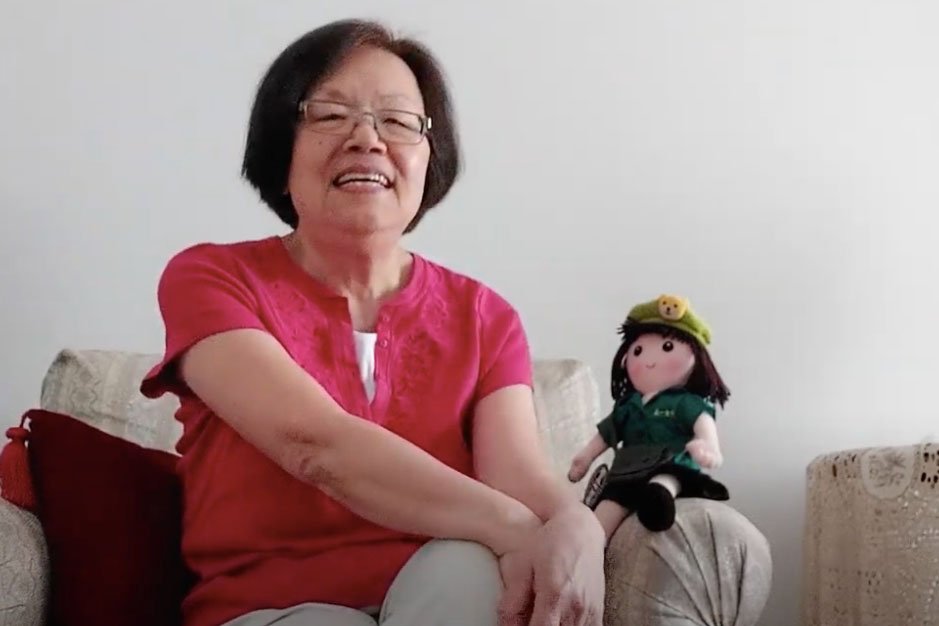Recollecting Taiwan through Taste, Physical Activity, and Sound
The photo is taken from our pre-interview session on 6/13/2022 at our central New Jersey home. My mom is with a doll from a Taipei First Girls alumni reunion event that she keeps displayed on a table.
A digital scan of a photograph from Hsin-Hsin Ho's college groups' mountain hiking trips in around 1973 or 1974. This is probably from Dabajian Mountain. Hsin-Hsin Ho on the bottom row, third from the right. Her husband, Tak-San Ho, is the right of her, although this is before they dated in the U.S.
Summary:
Alex Ho asks his mother, Hsin-Hsin Ho, to share musings on fruit, food, mountains, and music in Taiwan. Through these sensory topics, Hsin-Hsin Ho weaves a picture of the environment she grew up in that shaped her life and outlook.
___
Interviewed: 06/19/2022
Narrator: Hsin-Hsin Ho
Interviewer: Alex Jia-feng Ho
Interview length: 1h 43m
Interview Log
00:35 AH introduces the oral history to practice listening to and learning from his mother’s stories. Hsin-Hsin Ho (HH) adds that our family has had many conversations and that this is an opportunity to record and pass on more information about Taiwanese culture.
04:10 AH shares a general timeline of HH’s life established in our pre-interview, marveling at HH's 47 years of life spent in the U.S.
06:40 HH talks about growing up with her childhood garden growing guava, starfruit, fragrant melon, as well as oranges, banana, pineapple, mango, grapefruit. AH shares that seeing wax apples in Hawaii made him look at Taiwan in a different way.
12:00 HH talks about how her family ate fruits fresh, not treating them for desserts. HH brings up pineapple cakes as a popular treatment of fruit.
16:04 AH asks HH to talk about Buddha Head fruit which he remembers having in Danshui with family. HH describes the Buddha Head fruit and having it only during formal, traditional occasions.
23:00 AH remarks how HH makes beautiful cut fruit bowls for our household. HH says that she lived in a much bigger household and fruits were just provided fresh on plates for the family, but also for house guests.
26:00 HH shifts back to how fruits like papaya and guava fresher in Taiwan than in the U.S.
29:14 AH turns the conversation to another common Taiwanese ingredient, yams, and how they can be found in rice and rice porridge. HH shares her and her husband's memories of yams in Taiwan.
32:42 HH talks about how her mom made yam soup as a dessert, maybe including soup balls (“tangyuan”). HH describes Taiwanese food and the influence of mainland Chinese cultures.
39:09 HH adds that, growing up in a harbor town, she grew up with a lot of seafood. AH adds a recollection of visiting seafood markets in Keelung, and HH also agrees that there is a lot of seafood culture there.
42:10 AH shares that hiking is an important activity to his family and that HH hiked on a few of Taiwan’s tallest mountains with college friends. HH discusses Guanyin Mountain, which she grew up across the bay from.
47:25 HH describes hiking trips to Guanyin Mountain in elementary school and college. HH talks about mountain climbing clubs in Taiwan.
52:07 AH asks about HH’s trip to Jade Mountain, the tallest in Taiwan. HH talks about her trip to Jade Mountain and seeing snow. HH says the biggest memory is being very happy that she accomplished this feat and giving all of her equipment to her younger brother, who still is an avid mountain hiker and biker.
59:15 HH talks about hiking trips to two more mountains, Alishan Mountain and Dabajian Mountain. HH talks about how the Dabajian Mountain trip showed the organizers that the women were very capable.
1:03:30 HH talks about how all these trips were about socializing and mingling, since everyone was single, still. HH describes government-organized hiking trips on the east coast of Taiwan. HH remembers memories of singing, chatting, and telling ghost stories on hiking trips.
1:11:35 HH remembers that she learned about music in school and her impression of popular music growing up, in relation to parents’ attitudes, friends, and school.
1:15:48 HH shares that she started listening to popular music from Taiwan more when she was living in the U.S. because she felt homesick. HH remembers, at the “Chinese school” that AH attended and HH volunteered teaching, when she realized that many other Taiwanese parents were very familiar with this popular music.
1:18:40 HH shares her thoughts on a song called “Sio Bak Chang” sung by Teresa Teng and that she finds it very special because it is in Taiwanese dialect and gives you a feeling of homesickness. HH and AH reflect on hearing these songs when AH was little. HH also reflects on how Chinese language popular music has changed over time.
1:25:45 HH talks about how she accepts 70s music much more than recent music.
1:27:00 AH and HH listen to and reflect on the song “Jiu Gan Tang Mai Wu”.
1:33:02 AH asks HH about her experience in school bands. HH talks about her experience in school bands. HH remembers that she wasn’t allowed to join many school clubs growing up, but finally got a chance in college to join the harmonica club.

